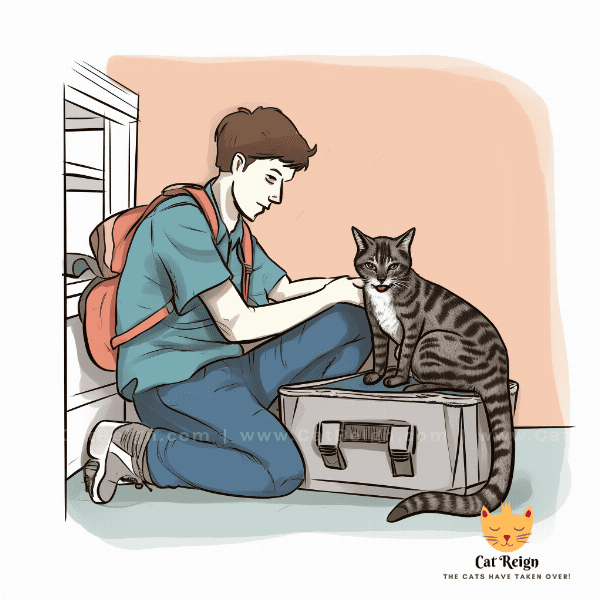Table of Contents
- Understanding Why Cats Scratch Door Frames
- Tips for Preventing Cats from Scratching Door Frames
- Using Deterrents to Keep Cats Away from Door Frames
- Providing Alternatives for Cats to Scratch
- Training Your Cat to Stop Scratching Door Frames
- Repairing Damaged Door Frames
- Seeking Professional Help for Severe Scratching Behaviors
- Conclusion: Maintaining a Scratch-Free Home with Your Feline Friend
Understanding Why Cats Scratch Door Frames
Cats are natural scratchers, and they use this behavior to stretch their muscles, mark their territory, and sharpen their claws. While scratching is a normal and necessary behavior for cats, it can become a problem when they start targeting your door frames.
Scratching as a Communication Method
Cats use scratching as a way to communicate with other cats and humans. By leaving visual and scent marks on the door frames, they are letting other animals know that this is their territory. If you have multiple cats in your home, you may notice that they each have their own preferred scratching spots.
Need for Exercise and Stimulation
Scratching also serves a physical purpose for cats. When they stretch and scratch, they are working out their muscles and keeping their claws healthy. Cats need regular exercise and stimulation to stay healthy and happy, and scratching is just one way that they meet this need.
Response to Stress and Anxiety
In some cases, cats may start scratching door frames as a response to stress or anxiety. If your cat is feeling anxious or frustrated, they may turn to scratching as a way to relieve tension and feel more in control of their environment.
Understanding why your cat is scratching your door frames is the first step in preventing this behavior. By providing your cat with appropriate outlets for scratching, addressing any underlying stress or anxiety, and taking steps to protect your door frames, you can maintain a happy and healthy relationship with your feline friend.

Tips for Preventing Cats from Scratching Door Frames
Preventing your cat from scratching your door frames requires a multi-faceted approach that addresses both their physical and emotional needs. Here are some tips to help keep your cat from scratching your door frames:
Provide Appropriate Scratching Surfaces
Cats need a designated place to scratch, and if you don’t provide one, they will find their own. Make sure your cat has access to a variety of scratching surfaces, such as scratching posts and pads, to help satisfy their natural scratching instincts.
Use Deterrents
If your cat is still scratching your door frames, consider using deterrents to discourage this behavior. Sticky tape, aluminum foil, or double-sided tape can be applied to the door frame to make it less appealing for scratching. You can also try placing a citrus-scented spray or other odor repellent around the door frame to deter your cat.
Create a Positive Association with Scratching Surfaces
Encourage your cat to use their designated scratching surfaces by making them more appealing. Place treats or toys on the scratching surface, or use catnip to attract your cat to the area.
Keep Your Cat Active and Engaged
Regular playtime and exercise can help prevent boredom and reduce stress, which in turn can help prevent destructive behaviors like scratching. Make sure your cat has plenty of toys and playtime each day to keep them mentally and physically stimulated.
Preventing your cat from scratching your door frames may take some time and effort, but it’s important for maintaining a harmonious relationship with your feline companion. By providing appropriate outlets for scratching, using deterrents, and keeping your cat active and engaged, you can help keep your home scratch-free.

Using Deterrents to Keep Cats Away from Door Frames
If your cat is persistent in scratching your door frames, using deterrents can be an effective way to stop this behavior. Here are some methods you can use to deter your cat from scratching your door frames:
Sticky Tape
Applying double-sided tape or sticky tape to the door frame can make it uncomfortable for your cat to scratch. The sticky surface will discourage them from continuing to scratch in that area.
Aluminum Foil
Cats dislike the sound and feel of aluminum foil, making it an effective deterrent. Simply wrap a strip of foil around the door frame, and your cat will be less likely to scratch in that area.
Odor Repellents
Cats have a keen sense of smell, and certain scents can be used to deter them from scratching your door frames. Citrus-scented sprays, such as orange or lemon, can be sprayed around the door frame to make it less appealing for your cat.
Commercial Sprays
There are several commercial sprays on the market that are designed to deter cats from scratching. These sprays typically contain unpleasant odors or tastes that cats dislike, such as bitter apple or vinegar.
It’s important to note that while deterrents can be effective, they should be used in combination with other methods to prevent scratching, such as providing appropriate scratching surfaces and keeping your cat active and engaged. By using deterrents in conjunction with other preventative measures, you can help keep your door frames scratch-free and maintain a happy relationship with your feline friend.

Providing Alternatives for Cats to Scratch
To prevent your cat from scratching your door frames, it’s important to provide them with appropriate alternatives for scratching. Here are some options to consider:
Scratching Posts
Scratching posts are a popular choice for providing cats with an appropriate place to scratch. They come in a variety of materials, including carpet, sisal rope, and cardboard, and can be placed in areas where your cat likes to scratch.
Scratching Pads
Scratching pads are another option for providing your cat with a designated scratching surface. They are usually made of cardboard or corrugated material and can be placed on the floor or mounted on a wall.
Scratching Towers
Scratching towers are multi-level structures that provide cats with a variety of surfaces to scratch, climb, and play on. They are a great option for multi-cat households or for cats that need extra stimulation.
Homemade Scratching Surfaces
If you’re on a budget, you can make your own scratching surfaces using materials like cardboard, carpet remnants, or sisal rope. Simply wrap the material around a sturdy object, such as a post or board, and secure it in place.
Providing your cat with appropriate scratching surfaces is an important step in preventing them from scratching your door frames. By offering a variety of options, you can help ensure that your cat is satisfied with their scratching choices and maintain a scratch-free home.

Training Your Cat to Stop Scratching Door Frames
Training your cat to stop scratching your door frames can be a challenging process, but with patience and persistence, it is possible. Here are some tips for training your cat to stop scratching your door frames:
Redirect Your Cat’s Attention
When you catch your Cat scratching the door frame, redirect their attention to an appropriate scratching surface, such as a scratching post or pad. Encourage them to scratch the new surface by using a toy or treat.
Use Positive Reinforcement
When your cat uses an appropriate scratching surface, reward them with praise, attention, or treats. Positive reinforcement will encourage your cat to continue using the designated scratching area.
Make the Door Frame Unappealing
Make the door frame unappealing for scratching by applying double-sided tape, aluminum foil, or a citrus-scented spray. When your cat attempts to scratch the door frame, they will be deterred by the unpleasant sensation or smell.
Avoid Punishment
Punishing your cat for scratching the door frame can be counterproductive and may cause them to become anxious or fearful. Instead, focus on positive reinforcement and redirecting their behavior to an appropriate scratching surface.
Seek Professional Help
If your cat’s scratching behavior is severe or persistent, it may be necessary to seek professional help. A veterinarian or animal behaviorist can help you determine the underlying cause of your cat’s behavior and develop a customized training plan to address it.
Training your cat to stop scratching your door frames may take time and effort, but it’s an important step in maintaining a harmonious relationship with your feline companion. By redirecting their attention, using positive reinforcement, making the door frame unappealing, and avoiding punishment, you can help your cat develop appropriate scratching habits and enjoy a scratch-free home.

Repairing Damaged Door Frames
If your cat has already caused damage to your door frames, it’s important to repair them as soon as possible to prevent further damage. Here are some tips for repairing damaged door frames:
Sand the Surface
Use sandpaper to smooth out any rough or jagged edges around the damaged area. This will help ensure that the new material adheres smoothly to the door frame.
Fill in the Gaps
Fill in any gaps or holes in the door frame using wood filler or putty. Apply the filler in thin layers, allowing each layer to dry before adding the next.
Sand Again
After the filler has dried, sand the surface again to smooth it out and prepare it for painting or staining.
Paint or Stain
Paint or stain the repaired area to match the rest of the door frame. Be sure to allow the paint or stain to dry completely before allowing your cat access to the area again.
Protect the Area
To prevent further scratching, consider applying a scratch-resistant material to the repaired area. Clear plastic adhesive sheets or metal protectors can be placed over the area to discourage your cat from scratching in that spot.
Repairing damaged door frames caused by your cat can be a time-consuming process, but it’s an important step in maintaining the structural integrity and appearance of your home. By filling in gaps, sanding, painting or staining, and protecting the area, you can help prevent future damage and maintain a harmonious relationship with your feline friend.

Seeking Professional Help for Severe Scratching Behaviors
In some cases, your cat’s scratching behavior may be severe or persistent, despite your efforts to prevent it. If this is the case, it may be necessary to seek professional help. Here are some options for seeking professional help for severe scratching behaviors:
Veterinarian
Your veterinarian can help determine if there are any underlying medical issues causing your cat’s scratching behavior. They can also recommend behavior modification techniques and medication if necessary.
Animal Behaviorist
An animal behaviorist is a specialist who can help diagnose and treat behavior problems in cats. They can develop a customized treatment plan for your cat, including training techniques, environmental modifications, and medication if needed.
Cat Trainer
A cat trainer can work with you and your cat to modify their behavior and prevent scratching. They can teach you techniques for redirecting your cat’s attention and encouraging them to use appropriate scratching surfaces.
Rescue Organizations
Rescue organizations may offer assistance for cat owners struggling with behavior issues. They may provide resources, training, or even take in the cat if rehoming is necessary.

Conclusion: Maintaining a Scratch-Free Home with Your Feline Friend
Living with a cat doesn’t have to mean living with scratched-up door frames. By understanding why cats scratch, providing appropriate scratching surfaces, and taking steps to prevent scratching, you can maintain a scratch-free home and a happy relationship with your feline friend.
Prevention is Key
Preventing scratching in the first place is the best way to maintain a scratch-free home. Providing appropriate scratching surfaces, using deterrents, and keeping your cat active and engaged can all help prevent scratching behavior.
Training and Repair
If your cat is already scratching your door frames, training techniques and repairs can help address the issue. Redirecting your cat’s attention, using positive reinforcement, and repairing any damage can all help prevent further scratching.
Seeking Professional Help
For severe or persistent scratching behaviors, seeking professional help can be a valuable step in addressing the problem. With the guidance of a veterinarian, animal behaviorist, cat trainer, or rescue organization, you can develop a customized treatment plan that helps prevent scratching and maintain a happy relationship with your feline friend.
Maintaining a scratch-free home with your cat requires patience, persistence, and a commitment to meeting your cat’s needs. By understanding why cats scratch, providing appropriate alternatives, and seeking help when necessary, you can enjoy a harmonious and scratch-free relationship with your furry companion.




